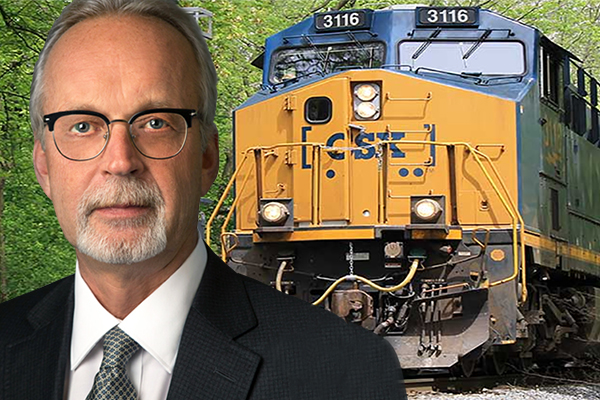CSX Provides Surface Transportation Board with Update on Precision Scheduled Railroading Progress

In a letter to leadership at the United States Surface Transportation Board, CSX CEO James Foote outlined the progress the Jacksonville, Fla.-based Class I freight railroad carrier has made in its ongoing implementation of Precision Scheduled Railroading.
Precision Scheduled Railroading
Precision Scheduled Railroading (PSR) was created by the late CSX President and CEO E. Hunter Harrison, who passed away in December.
PSR requires cargo to be ready when rail cars arrive for loading or risk being left behind, a practice that served both CP (Canadian Pacific) and CN (Canadian National Railway Company) well under his leadership, with both companies seeing multiple positive results in the form of lower operating ratios, improved service, record amounts of reinvestment into networks, as well as creating significant shareholder value.
But over the course of 2017 since Harrison took the helm at CSX, things have not been quite as smooth in terms of the PSR implementation.
There were various issues stemming from CSX’s PSR implementation that were clogging the tracks, so to speak, in various ways in the form of things like informal complaints from both CSX customers and railroad industry stakeholders in regards to various service issues, including:
- transit times increasing significantly and/or becoming unpredictable;
- loaded and empty railcars sitting for days at yards;
- switching operations becoming inconsistent and unreliable;
- car routings becoming circuitous and inefficient;
- CSX customer service being unable to provide meaningful assistance; and
- slowing train speed and increasing dwell time along with numbers of cars online.
CSX CEO James Foote’s letter to the United States Surface Transportation Board (STB) was in response to a December 14 letter from the STB, which centered on the company’s continued progress in implementing PSR.
He explained that PSR is comprised of two phases, with the first phase at CSX focused on what he called “top-to-bottom changes” into the way in which the railroad operated.
“Mr. Harrison introduced the company to a new way of thinking about CSX’ network, which led to major operational enhancements, including the conversion of certain hump yards to flat switching and strategic adjustments to other facilities,” he wrote.
“It also led to replacing CSX’ traditional methods with a new, balanced, scheduled train plan comprised of significantly more mixed-freight trains. Most importantly, Hunter instilled a new railroad culture that has everyone focused on the five tenets of PSR: service, asset utilization, controlling costs, safety and people.”
Addressing the second phase of PSR implementation, Foote cited “the pure, daily execution of those five PSR tenets,” which is well underway.
What’s more, he said that the results of PSR implementation are apparent, pointing to the company’s performance metrics showing a remarkable rate of positive change, with four straight months of improvement, coupled with recent trends far exceeding the prior full-year average and car handling and terminal fluidity ahead of 2016 levels. He also stated that major strides have been made in train velocity.
“Higher velocity serves as a catalyst for multi-faceted improvement,” he wrote. “As trains speed up on the network and reach their destinations sooner, there are fewer total trains running at any given time. This improved line-of-road fluidity, in concert with terminals processing cars more efficiently, leads to a higher level of on-time originations. When trains are operating in their scheduled windows and executing in timely coordination on meets and passes, movements further accelerate freight across the network. As a result, fewer locomotives and crews are needed to handle the same amount of freight, and our cars are able to cycle more quickly, such that total cars online decline. The end of this virtuous cycle is faster transit, better service, markedly improved asset utilization, and greater efficiency at lower cost.”
In concluding his letter, Foote said that he believes PSR is in place at CSX and does not foresee any significant operating changes at this time, adding that through this successful implementation, the company has seen enhanced freight flows across the CSX network and major progress toward its goal of providing a superior product for its customers.
Shortly before Harrison passed away in mid-December, CSX issued a statement noting that Harrison would be on medical leave and replaced by Foote on an interim basis.
At that time, Stifel analyst John Larkin wrote in a research note that the company’s strategy would be unchanged but the cultural conversion and rebuilding of customer confidence was required.
“After this summer’s service meltdown occurred at CSX the company moved rapidly and decisively to adopt Hunter Harrison’s precision railroading plan, service rapidly deteriorated,” Larkin wrote.
“Customers were irate and openly complained to the Surface Transportation Board. In the ensuing months, Hunter made numerous management changes as precision railroading requires complete ‘buy-in’ by everyone up and down the organization. Service improved and customer complaints subsided. But, scars from this service meltdown remain.”
“Mr. Foote may be better suited to repairing customer relationships and to further reinforce the need for everyone on the CSX team to simultaneously row in the direction of precision railroading execution. At its best, precision railroading improves service (transit times and transit time variability), lowers cost, and attracts more traffic to the adopting railroad. CSX is within striking distance of the Holy Grail here, and Mr. Foote may be just the right person to carry the ball over the finish line, given his extensive sales and marketing background, while at Canadian National.”
Related Article: CSX Corporation Announces New Chief Operating Officer & Executive Management Changes
CSX White Papers & Guides
2017 Supply Chain Trends
A pool of over 150 supply chain professionals were asked about their transportation plans, challenges and opportunities for growth, the results provide insight into a wide range of issues and shed light on what supply chain managers plan to focus on in the coming year. Download Now!
Your Guide to Upcoming Trucking Regulations
As increased over-the-road regulations are set to go into effect in 2017, supply chain managers should take steps to prepare today in order to protect their organizations from negative impact. Download Now!
The X’s and O’s of Intermodal Rail in Supply Chain Management
As the coach of your supply chain, you have the opportunity to turn to your playbook and choose from multiple transportation modes to maximize the efficiency of your freight network. Download Now!
The Intermodal Rail Bracketology Guide
Learn how to identify sub-optimal full-truckload freight that is vulnerable to capacity constraints if and when a supply chain disruption occurs. Download Now!
Practical Steps for Highway to Intermodal Rail
Learn how to increase access to capacity, reduce transportation costs and mitigate exposure to future trucking regulations. Download Now!
Transportation Management Systems & Intermodal Rail
An interactive, personalized guide to learn more about the combined benefits of a TMS and intermodal rail. Download Now!
Highway to Intermodal Rail (H2R) Conversions Deliver Bottom Line Results
CSX Transportation has found that 96% of shippers have sub-optimized freight in their network. Does your organization? Find out and learn how to address sub-optimized freight in your supply chain. Download Now!
Article Topics
CSX News & Resources
Signs of progress are being made towards moving cargo in and out of Baltimore Top CSX executive places a sharp emphasis on railroading as a career path and service at NEARS Intermodal innovation? Crisis averted on U.S. railroads, with carriers and unions reaching tentative agreements CSX’s acquisition of Pan Am Railways is a done deal Baltimore breaks ground for double-stacking 126-year-old tunnel in ‘absolute game-changer’ CSX executive discusses railroad trends and themes at NEARS conference More CSXLatest in Transportation
Baltimore Bridge Collapse: Impact on Freight Navigating Amazon Logistics’ Growth Shakes Up Shipping Industry in 2023 Nissan Channels Tesla With Its Latest Manufacturing Process Why are Diesel Prices Climbing Back Over $4 a Gallon? Luxury Car Brands in Limbo After Chinese Company Violates Labor Laws The Three Biggest Challenges Facing Shippers and Carriers in 2024 Supply Chain Stability Index: “Tremendous Improvement” in 2023 More TransportationAbout the Author






















